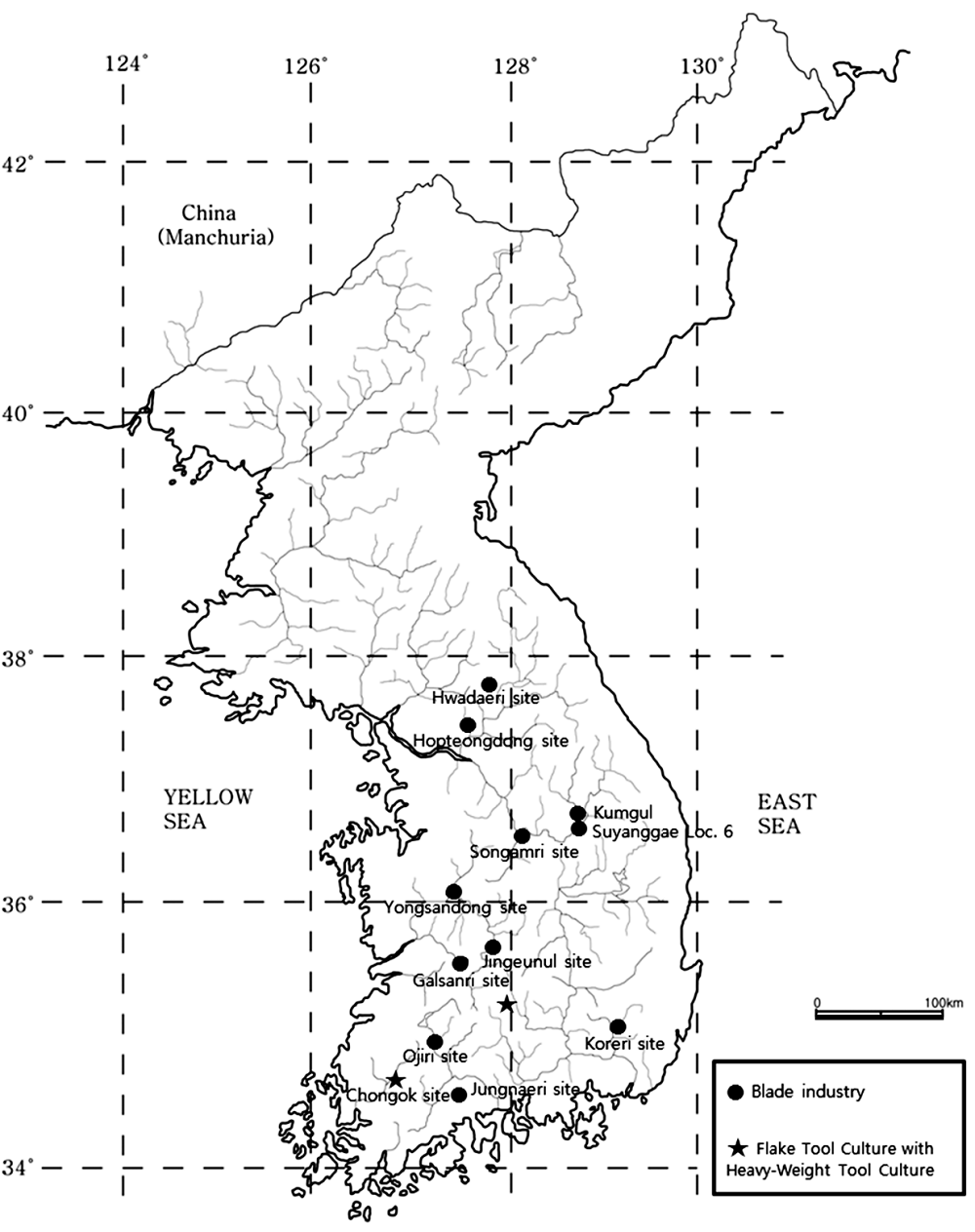

Chronology and characteristics of the Upper Palaeolithic blade tool industry in Korea
Received date: 2018-05-08
Revised date: 2019-01-02
Online published: 2020-09-10
This article describes the regional characteristics of blade tool assemblages in Korea and presents a general overview of human migrations into the Korean Peninsula based on recent research. Paleolithic sites with blade tool assemblages are rare in East Asia except for the Altai and other regions of Siberia, and Shuidonggou in North China. At the end of 1990, the remains of a typical blade tool industry were found at the Koreri site, Milyang City. For the last ten years, several important sites have been found in South Korea. Around 40 kaBP, blade tool assemblages appeared in the Korean Peninsula while the pebble tool tradition still existed in the early Upper Paleolithic. Most heavy-weight tools disappeared at typical blade tool sites. These consistent characteristics demonstrate that the blade tool industry was probably the result of migration. There is no evidence that a microblade industry(25~10 kaBP) replaced the blade tool industry in Korea. Rather, these two cultures were probably produced by different populations who migrated into the Korean peninsula. When groups using microblades rapidly spread throughout the entire Korean peninsula, the blade tool industry still coexisted from ca. 25 to 15 kaBP.

Key words: Blade; Upper Palaeolithic; Chronology; Characteristics; Korea
Heonjong LEE , Sangseok LEE . Chronology and characteristics of the Upper Palaeolithic blade tool industry in Korea[J]. Acta Anthropologica Sinica, 2019 , 38(03) : 373 -388 . DOI: 10.16359/j.cnki.cn11-1963/q.2019.0037
| [1] | Lee HJ. A study the conservative character and persistence of the pebble tool tradition in Korea, Hanguk Sanggosa Hakbo, 2002,38:27-52(In Korean) |
| [2] | Sohn BK. Report of site excavation research in Dodam-ri, Danyang-1983-84 year. Chungju Dam Sumoljigu. Report of site excavation research. Chungbuk University Museum, 1984: 213(In Korean) |
| [3] | Sohn BK. Report of site excavation research in Dodam-ri, Danyang -1985 year-Chungju Dam Sumoljigu Report of site excavation research. Chungbuk University Museum, 1985, 253pp(In Korean) |
| [4] | Lee HJ. Chronology of Upper Paleolithic in Korean Peninsula. 3rd international symposium: Suyanggae and her neighbors, 1998, 87-104 |
| [5] | Seo YN, Kim HJ, Jang YJ. Upper Paleolithic culture of Goryeri site, in Milyang-si, Kyengnam province. Youngnam Jibang Guseokki Munhwa, 1999, 47-64(in Korean) |
| [6] | Lee GK, Choi MN, Kim EJ. Soonchon jungnae-ri site, Korea, 2000. 1-319(in Korean) |
| [7] | Jang YJ. The study of core from Milyang Koreri site in Paleolithic age. 2001, 1-138(in Korean) |
| [8] | Jang YJ. Core reduction technology during the Upper Palaeolithic focusing on the Goryeri Collection Milyang Korea. Hanguk Guseokgi Hakbo, 2001,4:43-64(in Korean) |
| [9] | Lee GK. The Jingeuneul Upper Palaeolithic site in Jinan County of submerged area around the Yongdam Dam and its significance. Honam Gogohakbo, 2004,19:5-23(in Korean) |
| [10] | Cha MA. Study on the Spatial Distribution of Artefacts of the Upper Palaeolithic from Jingeunul Site in Jinan County Korea. 2007, 1-88(in Korean) |
| [11] | Lee GK. The cultural continuities and innovations in the Korean Upper Palaeolithic culture along with its interactions. Honam Gogohakbo, 2012,41:5-34(in Korean) |
| [12] | Lee HJ, No SH, Lee HY. Report on the excavation of Dangga Site, Chongokri site, Naju. 2004, 1-371(in Korean) |
| [13] | Lee HJ. Preliminary consideration of complexity of culture lines of the Upper Paleolithic in Korea. 15th international symposium: Suyanggae and her neighbors, 2010, 197-203 |
| [14] | Hong MY, Kim JH. Hopyeong-dong Paleolithic site(Namyangju, Gyeonggi Province, Korea) II. 2008, 1-850(in Korean) |
| [15] | Choi BK, Yu HJ. The Hwadae-ri Shimteo Paleolithic Site in Pocheon-si, Korea. 2005. 1-149(in Korean) |
| [16] | Lee HJ. Study of comparison of microblade core technical system of Upper Paleolithic in Northeast Asia. Dongbuka Mumhwa Yeongu, 2008,16:83-108(in Korean). |
| [17] | Institute of Korean Prehistory. Report on the Excavation of Songam-ri Waesil Site, Chungju. 2014, 1-331(In Korean) |
| [18] | Honam Cultural Property Research Center. Galsanri Site, Wanju. 2014, 1-476(In Korean) |
| [19] | Lee HJ, Lee SS. The characteristics and changes of blade tool techniques in Korea. 19th international symposium: Suyanggae and her neighbors in Poland. 2014, 103-112 |
| [20] | Jang YJ. Study on techniques and chronology of Upper Paleolithic age in Korea. 2007, 1-265(in Korean) |
| [21] | Lee HJ, Lee SS. The study of blade tool culture in Korea. 18th international symposium: Suyanggae and her neighbors, 2013, 109-114 |
| [22] | Lee HJ, Lee SS. Preliminary Study of characteristics and its change of blade core technical system in Korea. Hanguk Guseokgi Hakbo, 2014,29:21-48(in Korean) |
| [23] | Central institute of Cultural Heritage. The Paleolithic Site at Yongsandong of Daejeon. 2007, 1-265(in Korean) |
| [24] | Lee HJ. Correlation of chronology and techno-typological character of Upper Paleolithic in Korea, Hanguk Sanggosa Hakbo, 2004,44:5-22(in Korean) |
| [25] | Derevianko AP. Formation of blade industries in Eastern Asia. Archaeology. Ethnology & Anthropology of Eurasia, 2005,4:2-30 |
| [26] | Liu DC, Wang XL, Gao X, et al. Progress in the stratigraphy and geochronology of the Shuidonggou site, Ningxia, North China. Chinese Science Bulletin, 2009,54:3880-3886 |
| [27] | Madson DB, Oviatt CG, Zhu Y, et al. The early appearance and possible last persistence of Shuidonggou core-and-blade technology: implications for the spread of anatomically modern humans in Northeast Asia. Abstract of international symposium in commemoration of the 90th anniversary of the discovery of Shuidonggou, the 6th annual meeting of Asian Paleolithic Association and the 18th symposium of Suyanggae and Her Neighbors. 2013: 58-59 |
| [28] | Nian X, Gao X, Zhou L. Chronological studies of Shuidonggou(SDG) Locality 1 and their significance for archaeology, Abstract of international symposium in commemoration of the 90th anniversary of the discovery of Shuidonggou, the 6th annual meeting of Asian Paleolithic Association and the 18th symposium of Suyanggae and Her Neighbors. 2013, 66-67 |
/
| 〈 |
|
〉 |